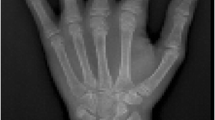Abstract
An 11-year-old male child who presented with increased frequency of urination, thirst and feeling of incomplete void was initially diagnosed with diabetes mellitus (DM) based on elevated blood sugar. Polyuria and polydipsia were confirmed even after normalisation of blood sugar. A standardised water deprivation test showed presence of central diabetes insipidus (DI) and patient was started on desmopressin. Presence of DM and DI led to suspicion of DIDMOAD/Wolfram syndrome and ophthalmic examination confirmed bilateral optic atrophy. Despite treatment for DM and DI the urinary complaints persisted, and ultrasound showed persistent bilateral hydronephroureterosis. Bladder workup including voiding cystourethrography (VCUG) and urodynamic study reported thickened trabeculated bladder wall along with overactivity, poor compliance and high bladder pressure. Bladder dysfunction has been documented to be associated with Wolfram syndrome and often may lead to chronic kidney disease which can be prevented by early diagnosis and appropriate management. The case highlights the need for comprehensive evaluation of children with urinary symptoms.
Similar content being viewed by others
References
Maleki N, Bashardoust B, Zakeri A, Salehifar A, Tavosi Z (2016) Diabetes mellitus, diabetes insipidus, optic atrophy, and deafness: a case of Wolfram (DIDMOAD) syndrome. J Curr Ophthalmol 27:132–135
Barrett TG, Bundey SE, Macleod A (1995) Neurodegeneration and diabetes: UK nationwide study of Wolfram (DIDMOAD) syndrome. Lancet 346:1458–1463
Karasik A, O’Hara C, Srikanta S, Swift M, Soeldner J, Kahn S, Herskowitz RD (1989) Genetically programmed selective islet beta-cell loss in diabetic subjects with Wolfram’s syndrome. Diabetes Care 12:135–138
Karzon R, Narayanan A, Chen L, Lieu J, Hershey T (2018) Longitudinal hearing loss in Wolfram syndrome. Orph J Rare Dis 13:102
La Valle A, Piccolo G, Maghnie M, D’Annunzio G (2021) Urinary tract involvement in Wolfram syndrome: a narrative review. Int J Environ Res Public Health 8:11994
Author information
Authors and Affiliations
Corresponding author
Ethics declarations
Competing interests
The authors declare no competing interests.
Additional information
Publisher's Note
Springer Nature remains neutral with regard to jurisdictional claims in published maps and institutional affiliations.
Rights and permissions
Springer Nature or its licensor (e.g. a society or other partner) holds exclusive rights to this article under a publishing agreement with the author(s) or other rightsholder(s); author self-archiving of the accepted manuscript version of this article is solely governed by the terms of such publishing agreement and applicable law.
About this article
Cite this article
Saha, S., Sinha, R. An adolescent male with persistent urinary symptoms. Pediatr Nephrol (2024). https://doi.org/10.1007/s00467-024-06424-3
Received:
Revised:
Accepted:
Published:
DOI: https://doi.org/10.1007/s00467-024-06424-3




